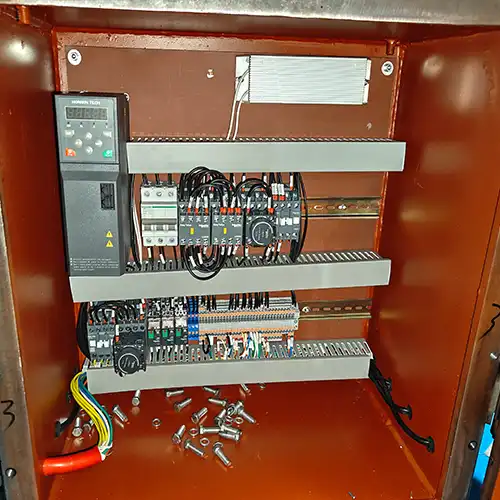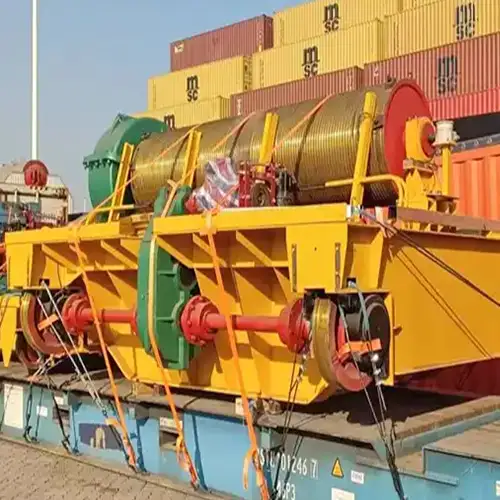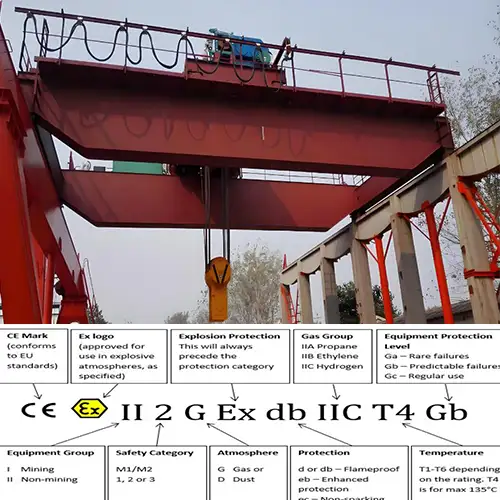Explosion-Proof Electric Control Cabinet, Exproof Hoist Crane Kit
Ensures crane safety in hazardous areas with sealed, spark-resistant electrical control,for explosion-proof hoist and crane. Get explosion proof crane kit!
Category: Crane Kit Parts
Your Trusted Explosion Proof Hoist and Crane Kit Manufacturer & Supplier
Explosion-Proof Electric Control Cabinet, Exproof Hoist Crane Kit
Ensures crane safety in hazardous areas with sealed, spark-resistant electrical control,for explosion-proof hoist and crane. Get explosion proof crane kit!
What is an Electric Control Cabinet for Hoist Cranes?
An electric control cabinet is the "brain" of a hoist crane system. It houses the electrical components that control how the crane operates.
It connects the power supply to the crane and manages all lifting and movement commands. When the operator presses a button or uses a remote, the signals pass through the control cabinet to the motors and brakes.
In short, the cabinet ensures the crane does what it's supposed to—safely and smoothly.
Key functions include:
- Distributing power to crane motors and control systems
- Managing lifting, lowering, and traveling actions
- Protecting the system from electrical faults like overloads or short circuits
- Enabling remote or automatic operation
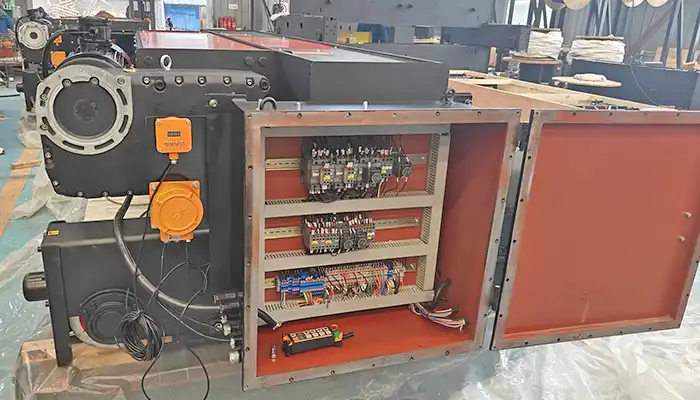
Explosion-Proof Control Box
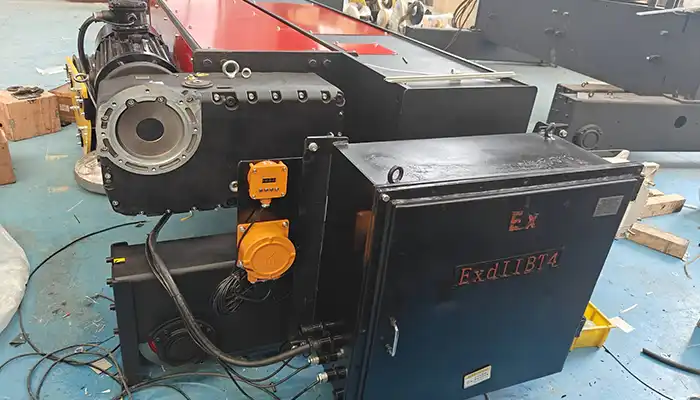
Explosion proof crane hoist kit - high safety for explosive environments
Why Is It Important in Crane Operation?
Without a good control cabinet, a crane can't perform reliably. Poor electrical control means poor safety and low efficiency.
The control cabinet acts like a traffic controller—if something goes wrong here, the whole system could fail or become dangerous.
Here's why it matters:
- Ensures smooth and stable lifting operations
- Helps prevent electrical accidents
- Makes sure the crane follows commands correctly
- Extends the lifespan of motors and equipment by avoiding overloads
Why Explosion-Proof Design Is Critical in Certain Industries
Some environments are risky—where flammable gases, dust, or vapors are present. Places like oil refineries, chemical plants, grain silos, or coal mines. In these areas, even a small spark could cause a fire or explosion.
That's where explosion-proof electric control cabinets come in. These are specially built to contain sparks, heat, or internal explosions—so they don't ignite anything outside the cabinet.
Industries that usually need explosion-proof cabinets:
- Oil and gas facilities
- Petrochemical and chemical processing plants
- Paint shops and fuel storage warehouses
- Mining operations and grain storage silos
Using explosion-proof control cabinets in these areas isn't just a good idea—it's a safety requirement. It protects both people and property.
Key Functions
Power Distribution and Electrical Control
The control cabinet manages the crane's entire power supply. It takes electricity from the main source and delivers it to different parts of the crane—like the hoist motor, traveling motor, and control panel.
It also makes sure the power is delivered safely and at the right level. Too much or too little power could damage the equipment or stop the crane from working properly.
Functions include:
- Connecting incoming power to crane systems
- Distributing electricity to motors, brakes, and switches
- Managing voltage and current flow for stable operation
Protection of Electrical Components
Cranes operate in tough conditions. Dust, moisture, heat, or vibration can cause damage. That's why the control cabinet includes built-in protection systems.
It shields sensitive parts like relays, contactors, and circuit boards from harm. It also stops electrical faults from spreading.
Typical protection features:
- Overload protection to prevent damage from too much current
- Short circuit protection for sudden failures
- Sealed enclosures to keep out dust and moisture
Coordinated Operation of Crane Movements
The cabinet isn't just a power box—it also controls how the crane moves. It coordinates hoisting, trolley travel, and bridge movement to make sure everything works smoothly and safely.
This helps avoid sudden jerks or crashes, especially when lifting heavy or delicate loads.
Control includes:
- Starting and stopping the hoist at the right time
- Synchronizing movement between motors
- Controlling braking systems for accurate stopping
Remote Control or Automation Support
Many cranes today come with remote controls or even full automation. The control cabinet plays a big part in that.It receives signals from wireless remotes, push-button stations, or PLC systems—and translates them into motion.This makes crane operation more flexible and often much safer, especially in hazardous zones.
Support may include:
- Wireless remote control receivers
- Inputs for PLC or automation systems
- Emergency stop and safety circuits
Explosion-Proof Design Standards
Standards You Should Know
Explosion-proof electric control cabinets must meet strict international or national safety standards. These rules ensure the equipment can operate safely in areas with explosive gases, dust, or vapors.
Common standards include:
- ATEX – Used in the European Union
- IECEx – International standard
- GB3836 – Chinese national standard for explosive environments
- NEC/CEC (Class/Division system) – Used in the U.S. and Canada
Always check which standard is required in your country or industry.
Types of Explosion-Proof Protection
Different designs are used to stop sparks or heat from causing an explosion. Each method offers protection in different ways.
Main types include:
- Flameproof (Ex d) – Contains any explosion inside the box
- Increased Safety (Ex e) – Designed to reduce the risk of sparks or heat
- Intrinsically Safe (Ex i) – Limits energy so that sparks can't ignite anything
The right type depends on the specific environment and equipment setup.
Hazardous Area Classifications
Not all dangerous areas are the same. Explosion-proof equipment is selected based on how likely explosive gases or dust are present.
Common classifications include:
Zone system (IEC/ATEX):
- Zone 0: Explosive gas present continuously
- Zone 1: Explosive gas likely during normal operations
- Zone 2: Explosive gas is rare and only for short periods
Division system (NEC):
- Division 1: Hazardous materials are present under normal conditions
- Division 2: Hazardous materials are present only during failures or maintenance
Knowing your classification helps you choose the right explosion-proof cabinet. It's all about matching the risk level with the right level of protection.
Main Components
A good explosion-proof control cabinet is more than just a metal box. Inside, every component has a specific job. Each part helps the crane work safely and smoothly—even in hazardous environments.
Explosion-Proof Enclosure
This is the outer shell of the cabinet. It's built to contain any sparks, flames, or pressure caused by an internal fault—so nothing dangerous escapes into the surrounding area.
Key features:
- Strong and sealed construction (usually steel or cast aluminum)
- Meets explosion-proof safety ratings (ATEX, IECEx, etc.)
- Keeps out gas, dust, and moisture
Circuit Breakers (MCBs or MCCBs)
These breakers protect the system from overcurrent and short circuits. When something goes wrong—like a sudden surge—they shut off the power to prevent damage.
They offer:
- Quick response to faults
- Easy reset after tripping
- Protection for both control and power circuits
Contactors and Relays
These are the switches that turn motors on and off. They open and close circuits based on signals from the control system.
They help:
- Control hoisting, traveling, and braking motors
- Operate auxiliary systems (like lights or alarms)
- Provide isolation for maintenance or safety
Frequency Inverter or Soft Starter (Optional)
Not always included—but very useful for smoother control. A frequency inverter adjusts motor speed. A soft starter reduces the electrical shock when a motor starts.
Used for:
- Variable speed hoisting or traveling
- Energy savings
- Reducing wear on motors and gearboxes
Overload and Short-Circuit Protection Devices
These protect the motor and wiring from overheating or being damaged by too much current.
Functions include:
- Shutting down power before damage occurs
- Keeping your crane safe during unexpected events
- Avoiding costly repairs or downtime
Control Transformer
This changes the incoming power voltage to a lower, safer level for control circuits—usually 24V or 48V. It separates high voltage from low-voltage components for extra safety.
Why it's important:
- Safe operation of buttons, relays, and logic units
- Protects sensitive components from power spikes
Terminal Blocks and Wiring
These are the connection points where wires meet. A well-designed terminal setup makes installation and maintenance easier.
Benefits:
- Clean and organized layout
- Easier troubleshooting and testing
- Secure wire connections
PLC or Logic Controller (Optional)
Some cabinets include a programmable logic controller (PLC). It handles automatic tasks like sequencing, timers, or sensor-based control.
Good for:
- Semi-automated or fully automated cranes
- Custom logic and operation routines
- Reducing the need for manual control
Human Machine Interface (HMI) or Control Display (Optional)
This is a screen or panel that shows the crane's status. It lets the operator see what's going on and adjust settings if needed.
Can include:
- Fault indicators
- Speed and load information
- Manual control buttons or touchscreen
Explosion-Proof Cable Glands and Fittings
These are small, but very important. They seal off the openings where cables enter or exit the cabinet. This keeps the entire unit safe and airtight.
They ensure:
- No flammable gas or dust gets inside
- Cables stay secure and undamaged
- The enclosure maintains its explosion-proof rating
Customizations Based on Crane Type
Control cabinets can be built differently depending on how your crane moves and operates.
Examples:
- Single-speed hoists: Simple cabinet with basic controls
- Dual-speed hoists: Extra relays or speed controls inside
- VFD-controlled cranes: Needs a frequency inverter and more ventilation
Always match your cabinet design with your crane's lifting features. It avoids future upgrades or rework.
Materials and Construction
Explosion-proof control cabinets are made to survive tough environments. The material and construction details matter just as much as what's inside.
Common Materials Used
Most cabinets are built with durable metals that can handle industrial use.
Popular options:
- Powder-coated steel – Strong, low-cost, and corrosion-resistant
- Stainless steel – Rust-proof and ideal for chemical or food plants
- Aluminum alloy – Lightweight and good for explosive zones (non-sparking)
Each material has its best use depending on your site conditions.
Corrosion-Resistant Finishes
The outer finish protects the cabinet from chemicals, water, or salty air.
Options include:
- Powder coating for added toughness
- Epoxy or anti-rust coatings for coastal or offshore areas
- Stainless finishes for long-term resistance in humid or acidic environments
These coatings help your cabinet last longer and keep safety intact.
Gasket-Sealed Doors and Ventilation
Sealing is critical. Gaskets around the door edges prevent gas, dust, and moisture from getting inside.
What to check:
- Doors should have rubber or silicone gaskets
- Ventilation filters or breathable membranes are used to prevent pressure buildup
- Internal fans or heat exchangers can be added for temperature control
Good sealing keeps components safe. Smart ventilation avoids overheating.
IP Protection Ratings
IP (Ingress Protection) ratings show how well the cabinet is sealed against solids and liquids.
Typical ratings include:
- IP55 – Protected from dust and water jets
- IP65 – Fully dust-tight and protected from low-pressure water
For outdoor or dusty environments, IP65 is usually recommended. Indoor or mild-duty cranes may only need IP55.
Installation and Compatibility
When you're installing an explosion-proof control cabinet, it's crucial to follow proper guidelines. This ensures everything works safely and as intended.
Mounting and Installation Guidelines
Installation is a key step in making sure your system runs smoothly.
- Wall-mounted cabinets need a solid surface that can hold the weight. They should be easy to reach for maintenance but protected from any direct exposure to hazardous conditions.
- Floor-standing cabinets need enough space for proper ventilation and to keep wiring and components accessible.
When installing, make sure the cabinet is level and securely fastened. This helps prevent vibrations and ensures the control system stays stable.
Compatibility with Different Power Supplies
Your crane's control cabinet must work with the power supply available at your site.
- Voltage: Cabinets are designed for specific voltage ranges (e.g., 380V, 415V). Make sure the cabinet matches the local voltage.
- Frequency: Check if the frequency (50Hz or 60Hz) is compatible with the equipment.
- Phase: Depending on your crane setup, it may need single-phase or three-phase power. Ensure the cabinet matches the crane's phase requirements.
Make sure to confirm these before installation to avoid power issues.
Wiring Connections
Correct wiring ensures the crane operates safely.
- Hoist motor: Connect to the motor controller inside the cabinet.
- Crane motor: Connect to power distribution and speed control systems.
- Limit switches and sensors: These safety devices tell the crane to stop at certain positions. Wire them carefully to the control cabinet.
- Remote controls: Wireless or wired controls must be linked to the cabinet's input system.
For safety, ensure all connections are clearly labeled and secured. Use proper cables and wire sizes to avoid overloading.
Full Integration with Explosion-Proof Hoists and Cranes
When integrating an explosion-proof crane with the control cabinet, it's essential that all components work together smoothly. The control cabinet must be able to handle the specific load and movement requirements of your hoist and crane system.
- Ensure the cabinet's protection type matches the crane's rating.
- Check that overload and short-circuit protections are correctly wired for hoist and motor safety.
- Verify that automation systems or remote controls are connected properly.
Application
Explosion-proof control cabinets are used in industries where hazardous materials or conditions are present. Here are some typical application scenarios.
Petrochemical Processing Plants
In petrochemical plants, there are often flammable gases or dust in the air. Explosion-proof control cabinets keep cranes operating safely in these dangerous environments.
Why they're needed:
- Cranes often lift heavy loads of chemicals or equipment in explosive zones.
- Explosion-proof cabinets prevent ignition, protecting workers and equipment.
LNG Terminals and Refineries
Liquefied Natural Gas (LNG) terminals and refineries involve handling highly flammable materials. Explosion-proof cabinets are a must here for both safety and compliance with industry regulations.
Why they're needed:
- Cranes handle heavy equipment and transport flammable liquids.
- Keeping electrical components safe from sparks is critical in preventing disasters.
Coal Mines and Grain Handling Facilities
Coal dust and grain dust are highly combustible. Explosion-proof control cabinets help prevent ignition from sparks or heat, ensuring that cranes used in these settings operate safely.
Why they're needed:
- Handling bulk materials in confined spaces increases the risk of sparks causing explosions.
- The control system must be robust enough to handle dusty, potentially explosive environments.
Paint Shops and Hazardous Material Storage Zones
Paint shops and storage zones for hazardous materials often involve vapors that could ignite. An explosion-proof control cabinet prevents any electrical spark from reaching these volatile substances.
Why they're needed:
- Cranes in these areas may transport heavy equipment or materials coated in flammable chemicals.
- The electrical system needs to be sealed and safe from sparks to ensure smooth, secure operation.
Why Choose Us?
When you're buying an explosion-proof control cabinet for your crane system, you're not just buying a box of wires. You're investing in safety, performance, and long-term reliability. Here's what sets us apart and why many crane users trust our cabinets.
Certified and Built to Industry Standards
Our explosion-proof control cabinets meet strict safety and performance requirements. Every unit is designed with compliance in mind.
- Certified according to ATEX, IECEx, GB3836, and NEC standards depending on your region and site needs
- Designed for safe use in hazardous zones with flammable gas, vapor, or combustible dust
- Each cabinet is tested and verified for explosion-proof integrity and electrical safety before shipment
If your worksite demands reliable protection, we make sure our cabinet meets the code.
Tailored for Overhead Cranes and Hoists
Crane applications are not the same as general-purpose industrial systems. That's why we customize each cabinet specifically for crane operations.
- Supports single-speed, dual-speed, or VFD-based hoist motors
- Includes logic for hoisting, long travel, cross travel, braking, and limit switch control
- Designs available for top-running, underrunning, gantry, or jib cranes
You don't have to worry about mismatched features. We'll make sure the cabinet matches your crane type exactly.
Compliant with CE and ISO Certifications
Product quality isn't just about materials—it's about process and documentation.
- Our factory follows ISO 9001 quality management standards
- All products carry the CE mark, meaning they're tested for safety and electromagnetic compatibility
- Detailed electrical drawings and testing reports come with every shipment
This makes it easier for your engineering team, project manager, or third-party inspector to approve and install with confidence.
Durable Materials, Industrial-Grade Components
Our cabinets are built for real-world use—often in extreme, outdoor, or high-risk conditions.
- Cabinets are made of powder-coated carbon steel, stainless steel, or aluminum alloy depending on corrosion risk
- All components are selected for long service life, heat resistance, and stable operation
- Internal layout is designed for easy wiring, maintenance access, and ventilation
You can count on fewer breakdowns, reduced downtime, and a longer working life.
Full Technical Support and Inspection Options
We don't just ship a product—we work with you to get it right.
- Our engineering team will review your crane specs and offer tailored cabinet designs
- We provide wiring diagrams, terminal labels, and even videos for installation if needed
- Optional third-party inspection (SGS, BV, or local agencies) is available before delivery
From quotation to installation, we're here to support your project.
Selection Guide: How to Choose the Right Cabinet
Selecting the right explosion-proof control cabinet doesn't need to be complicated—but it does require clear information. Here's how you can make the right choice for your crane system.
1. Know the Explosion-Proof Rating You Need
First, check your site's hazardous area classification. This determines the required level of protection.
- Zone 1: Area where explosive gas is likely during normal operation
- Zone 2: Gas is unlikely, but may appear occasionally
- Zone 21/22: For dust environments, such as coal or grain handling
- Division 1 or 2: Used in some regions (like the U.S.) for similar classifications
Let us know your zone or division, and we'll select the right enclosure and components.
2. Define the Control Mode
Your operation method affects the wiring and component layout of the cabinet.
- Manual: Buttons, selector switches, and local control panels
- Remote Control: Wireless or wired remote input, requires signal receivers
- Automated: PLC-based control with sensors, HMI screens, or system integration
Each setup has different space, signal, and protection requirements.
3. Match the Power Supply
The cabinet must be compatible with your site's power.
- Voltage (e.g., 220V, 380V, 415V, or 480V)
- Frequency (50Hz or 60Hz)
- Phase (Single-phase or Three-phase)
These basics help us select the right transformer, breakers, and wiring inside the cabinet.
4. List All Controlled Devices
Think about what you want this cabinet to control—both now and in the future.
- Hoist motor (lifting)
- Travel motors (long travel and cross travel)
- Limit switches (upper/lower, end stops)
- Brakes, alarms, indicator lights
- Spare circuits for future expansion
Providing this list helps us size the cabinet correctly and avoid issues during installation.
5. Pre-Order Checklist
To help us give you a fast and accurate quotation, please prepare:
- Explosion-proof zone (Zone 1/2, Division 1/2, etc.)
- Voltage, frequency, and phase details
- Crane type (e.g., single girder, double girder, gantry)
- Desired control method (manual, remote, or PLC)
- Special features (soft starters, VFDs, HMI, remote systems)
- Quantity needed and your lead time
With this info, we can offer the best solution for your crane system, tailored to your site and needs.
Maintenance and Safety Guidelines
An explosion-proof control cabinet is built for long-term use, but regular checks and proper maintenance are essential. Following basic safety steps helps avoid failures, protects workers, and ensures compliance.
Routine Inspection and Preventive Maintenance
Regular checks keep your system reliable and safe. It's always better to catch problems early.
- Inspect gasket seals, door locks, and enclosures for wear or damage
- Clean dust, moisture, or any buildup from vents or cable entries
- Check that indicator lights and emergency stop buttons are working
- Tighten terminals and recheck connections every few months
We recommend a monthly visual check, and a full inspection every 6 to 12 months, depending on the work environment.
Replacement and Service Guidelines
If a component fails or wears out, replace it with certified parts.
- Only use approved explosion-proof parts (like contactors, relays, or cable glands)
- Avoid using standard components, even if they "seem to fit"—they may compromise the cabinet's safety rating
- Replace worn labels, stickers, or cable tags to avoid future confusion during troubleshooting
Always power down the system and follow lock-out/tag-out (LOTO) procedures before servicing.
Proper Grounding and Bonding
Grounding is not optional—it's critical for electrical safety and explosion-proof performance.
- Make sure the cabinet is firmly grounded to your facility's earthing system
- Use correct cable sizes and bonding straps for all metal parts
- Double-check that grounding is intact after relocation or rewiring
Bad grounding is a common cause of electric shock, noise issues, and even explosions.
Common Troubleshooting Tips
Sometimes things stop working—and often, it's something simple.
- No power? Check the main breaker, incoming voltage, and fuses
- Strange behavior? Inspect the control transformer and relays for wear
- Motor not starting? Confirm the remote signal is reaching the cabinet, and that limit switches are not engaged
- Alarms on VFD or soft starter? Review the fault code, reset if needed, or call us for advice
When in doubt, don't guess—reach out to our support team. We're always ready to help.
Contact and Support
We know that industrial projects require fast answers, reliable support, and clear communication. From the moment you reach out, we're here to help make your buying process smooth and worry-free.
How to Get a Quotation
Getting a quote is quick and simple. Here's what we need from you:
- Your crane type and work environment
- Explosion-proof classification (Zone, Division, or dust/gas)
- Power supply details (voltage, frequency, phase)
- Number of motors and control requirements
- Any extras (like remote control, HMI, or soft starters)
Once we get your details, we'll reply with a full quotation, cabinet layout, and delivery timeline.
Technical Consultation Services
Need help figuring out what you need? No problem.
- Our engineers can review your specs and recommend a setup
- We can assist in matching our cabinet with your existing hoist or crane system
- Layout drawings and technical datasheets are available upon request
We'll work with your team to make sure everything fits—no confusion, no guesswork.
Installation Help and After-Sales Support
Support doesn't stop when your order ships.
- We offer installation guidance, including wiring diagrams and terminal labels
- Online support is available if your team runs into problems during setup
- For long-term use, we can supply spare parts, upgrades, or even replacement units
You can always count on fast replies and real help—before and after the sale. Contact us to learn more on explosion proof crane kit!
Related Products
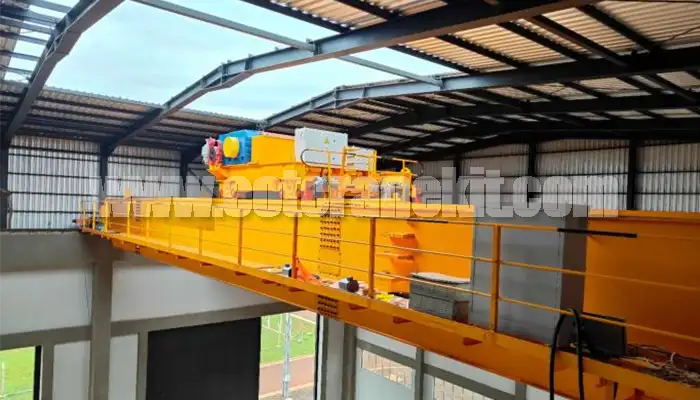
Latest project
150 Ton Overhead Crane Installation Feedback – Paraguay Case
QDX 150 ton overhead crane in action in Paraguay. Installation photos, video, and client feedback show performance, safety, and heavy-lifting efficiency.
Free consultation to Confirm Parameters & Specifications and Get
Latest Crane Price & Crane Rate.
- Types of overhead cranes : _______?
- Optional: Overhead travelling crane, goliath gantry crane,Slewing jib crane, Single girder or double girder crane,small portable crane or kbk crane, etc.
- Capacity of overhead crane: _______?
- Optional: 0.25ton, 0.5 ton, 1 ton, 2 ton, 3ton, 5 ton, 10 ton,15ton, 20ton, 25 ton, 30ton,35ton, up to 550ton, etc.
- Crane span & lifting height : _______?
- Crane travelling length : _____?
- Control of overhead crane:_______?
- Optional: pendant/ remote/cabin control
- Voltage supply of overhead crane:_____?
- Eg,: 380V50/60HZ,3Phase or others,etc.
- Application/usage of crane:_______?
- Eg,: Steel mill, ,injection mold, cement,stone, concrete,granite, general manufacturing, etc.
Just leave a message via the contact form and our hoist and crane engineer will contact you with in 24working hours.
Get In Touch
